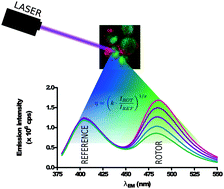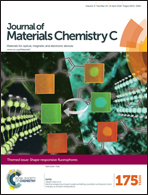Ratiometric mechanosensitive fluorescent dyes: design and applications
Abstract
Fluorescent molecules, with their almost instantaneous response to external influences and relatively low-cost measurement instrumentation, have been attractive analytical tools and biosensors for centuries. More recently, advanced chemical synthesis and targeted design have accelerated the development of fluorescent probes. This article focuses on dyes with segmental mobility (known as fluorescent molecular rotors) that act as mechanosensors, which are known for their relationship of emission quantum yield with microviscosity. Fluorescence lifetime is directly related to quantum yield, but steady-state emission intensity is not. To remove confounding factors with steady-state instrumentation, dual-band emission dyes can be used, and molecular rotors have been developed that either have intrinsic dual emission or that have a non-sensitive reference unit to provide a calibration emission band. We report on theory, chemical structure, applications and targeted design of several classes of dual-emission molecular rotors.

- This article is part of the themed collection: Shape-Responsive Fluorophores

 Please wait while we load your content...
Please wait while we load your content...